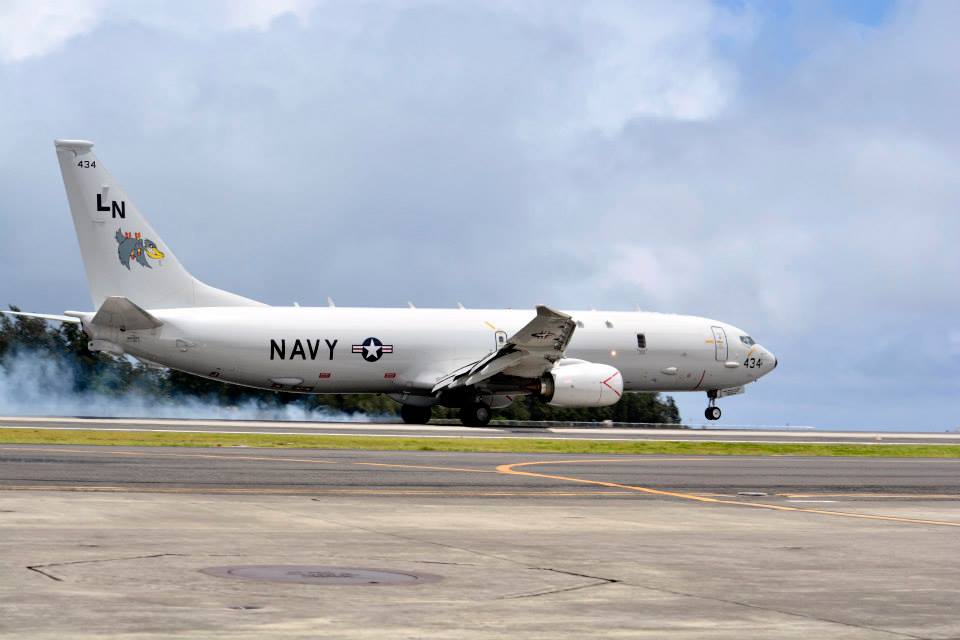
The U.S. Navy is cutting its teeth on the new Boeing P-8A Poseidon long range maritime Multi-Mission Aircraft with deployments to the U.S. 7th Fleet Area of Responsibility (AOR), with the third rotation of the type currently ongoing at Kadena Air Base in Okinawa, Japan since the first one began at the end of 2013. A typical deployment to Kadena lasts between six to seven months, and currently consists of a single squadron of Lockheed Martin P-3C Orions and one of P-8As to demonstrate the ability of the two platforms to operate effectively in a high-tempo environment.
Starting in late January, Patrol Squadron (VP) 45 arrived at Kadena Air Base from Naval Air Station Jacksonville, Fla. with six aircraft to conduct its first deployment to the 7th Fleet AOR since completing the transition to the Poseidon from the P-3C in early 2014.
This was followed by an intensive year-long Inter-Deployment Readiness Cycle (IDRC) to prepare for their inaugural deployment with the new aircraft which included joint and multinational exercises designed to enhance interoperability between the U.S. and its allies. As part of the IDRC, VP-45, also known as the Pelicans, sent aircrews and maintainers all over the globe, including Estonia, Iceland, Hawaii, Guam, Bermuda, England, Peru and Chile supporting exercises such as BALTOPS, RIMPAC, Valiant Shield, Joint Warrior, SIFOREX and Teamwork South.
The Pelicans officially relieved the P-8s and personnel of VP-5 Mad Foxes on Feb. 10 and soon got down to business, undertaking a three-week deployment to the Philippines which included hosting military personnel from the Philippines on a patrol off Luzon Island to “demonstrate the P-8A’s capabilities in both the littoral and open ocean environment and the flight characteristics of the P-8A in both high altitude reconnaissance missions and low altitude patrol regimes”, according to a press release issued by the 7th Fleet.
This is the first time the U.S Navy has acknowledged flying P-8s from the Philippines. According to Col. Restituto Padilla, a spokesman for the Philippine armed forces, the Poseidons replaced the Orions on the rotations in 2014 but no announcement had been made till now.
The Pelicans flew a total of 180 hours while on its Filipino sojourn, flying over waters where the hotly disputed Spratly Islands are located. China, the Philippines and four other Southeast Asian nations are embroiled in a dispute over overlapping sovereignty claims to the potentially resource-rich islands.
One such P-8A flight over the South China Sea by a VP-5 P-8A last year was intercepted by an armed Chinese Shenyang J-11B interceptor over international airspace near China’s Hainan Island, leading to accusations by the U.S. Department of Defense that the J-11B, belonging to the People’s Liberation Army Navy, flew dangerously close and performed dangerous maneuvers in the vicinity of the P-8.
In late Febuary, the Pelicans despatched one squadron aircraft each to airshows in Bangalore, India and Avalon, Australia which are incidentally both export customers of the P-8. It was at Avalon that James Detwiler, Boeing’s P-8 Business Development Director for Maritime Systems, briefed the media on several aspects of the program, including details about deployments to the 7th Fleet AOR.
According to Detwiler, mission profiles flown by the P-8s include Anti-Submarine and Anti-Surface Warfare, Maritime Patrol, High-Altitude Intelligence, Surveillance and Reconnaissance (ISR), Command, Control and Communications (C3) and providing standoff targeting for other U.S. Navy assets.
However, it was the search for the missing Malaysian Airlines flight MH370 in March and April 2014, during the P-8’s first 7th Fleet AOR deployment, that provided the U.S. Navy with the greatest insight into the aircraft’s capabilities. During the second phase of the air search, which saw involved aircraft making 1,200 – 1,400 nautical mile transits from airports in Western Australia to the southern Indian Ocean search area, the U.S. Navy initially utilized a single P-8A from VP-16 War Eagles and a P-3C.
However, the long transits soon saw the addition of a second P-8A from VP-16 and the withdrawal of the P-3 due to the P-8s getting “three to four hours additional on-station time, partly because it has a higher transit speed” in the words of Boeing’s Detwiler. On top of this, it was found that the operational fuel burn on the P-8 was a lot less than that predicted by computer modelling performed during the type’s development, even when the aircraft was operating at altitudes as low as 200 feet for significant periods of time. This meant that the P-8 was capable of up to twelve hours on station during the search for MH370, with crews reporting less fatigue than that encountered on comparable missions flying on P-3s due to increased ride comfort.
The United States has already committed to acquiring 117 P-8s, with Boeing having already delivered 21 aircraft to date. Australia has ordered eight more aircraft, with four more on option. The P-8’s room for future growth, which Boeing has already planned for with increased capability known as Increment II and Increment III, will see wideband Satellite Communications equipment, High Altitude Anti-Submarine Warfare and inflight refuelling capability added to an already very capable aircraft.





